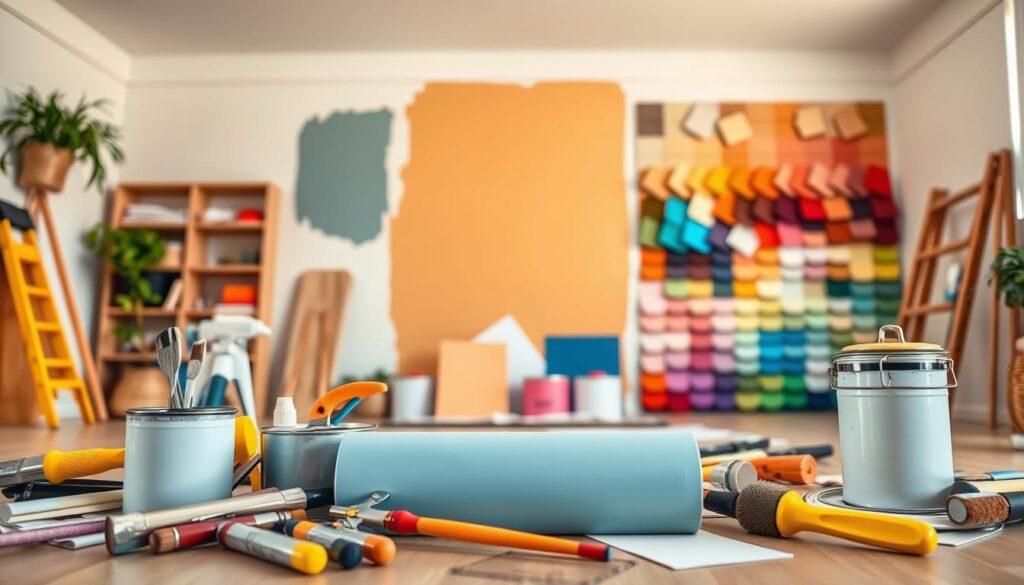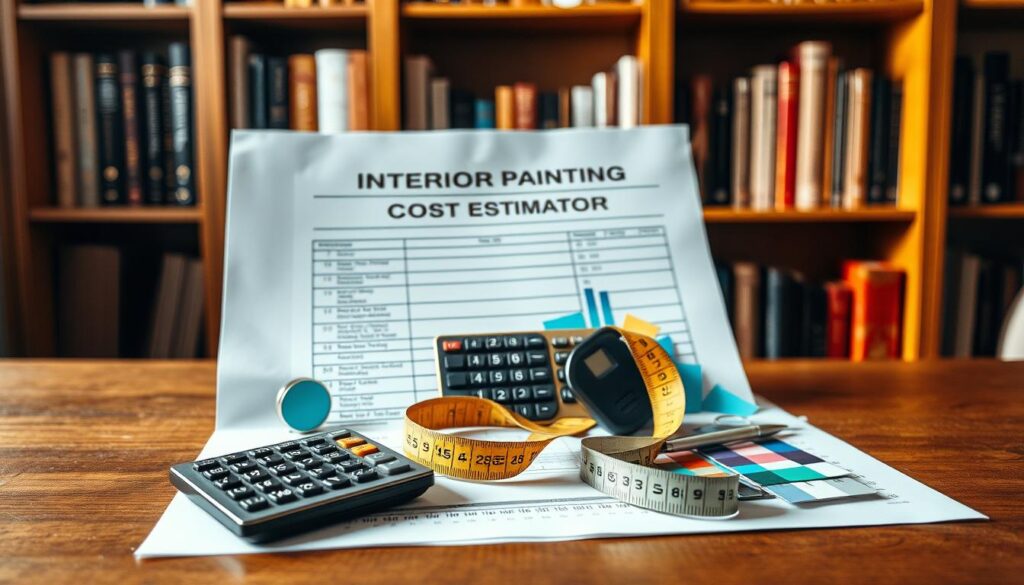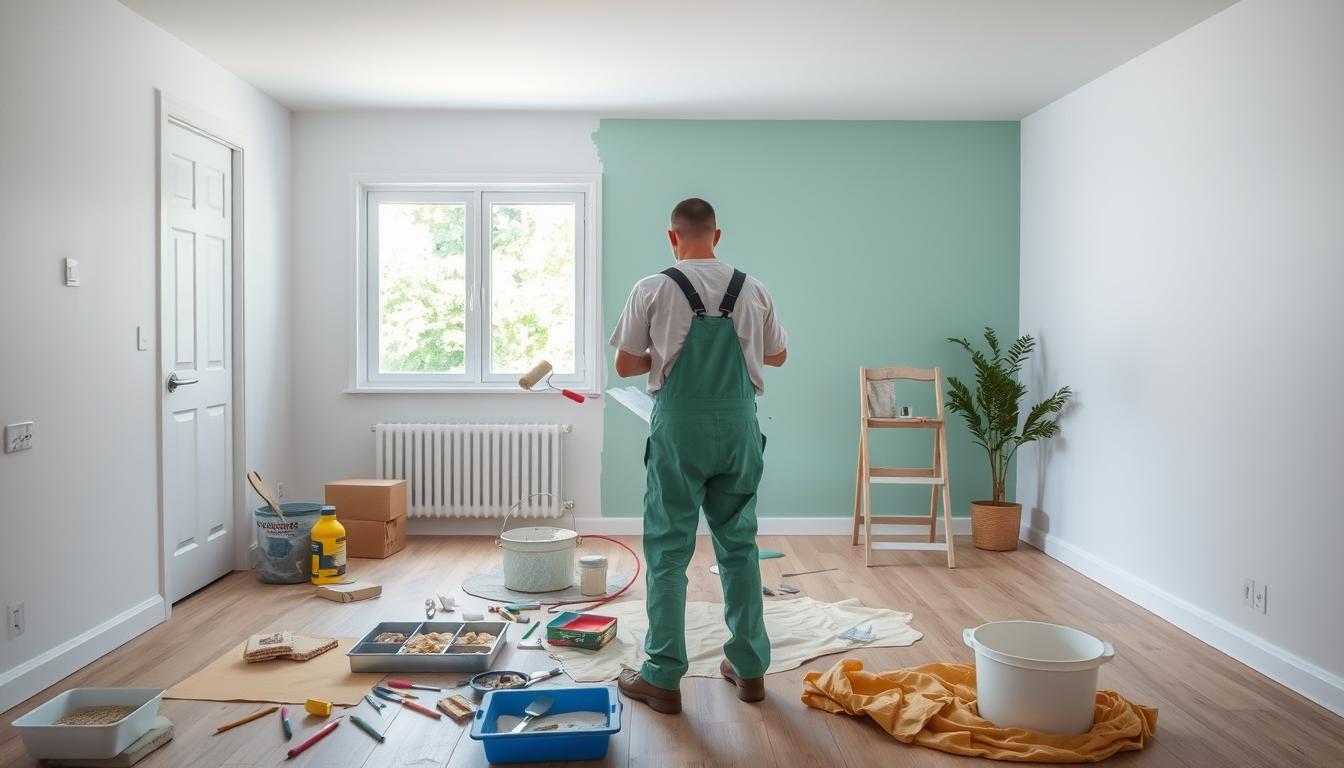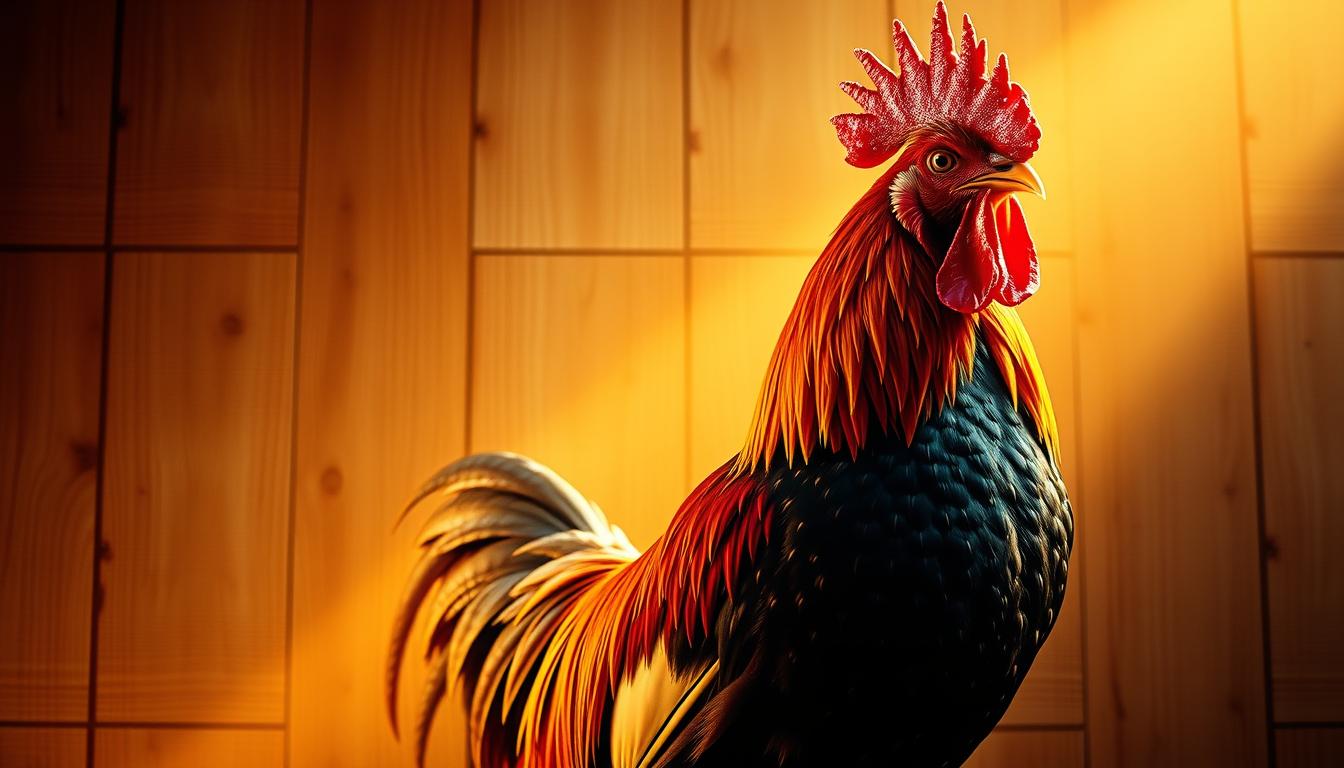Did you know painting your home’s interior can cost between $967 and $3,076? On average, homeowners spend about $2,014. The cost varies based on your home’s size and the paint type.
Knowing what affects the cost is key for planning your painting project. Whether you choose to hire a pro or do it yourself, costs can add up fast. We’ll look at the main factors that influence interior painting costs, guiding you to make smart choices.
Key Takeaways
- The average cost to paint a house interior ranges from $967 to $3,076.
- Factors such as home size and paint type significantly influence the total cost.
- Deciding between hiring a professional and DIY can greatly impact your expenses.
- Understanding these factors helps in better budgeting and planning.
- Additional costs may include preparation work, materials, and labor.
Understanding the Factors Affecting Interior Painting Costs
Knowing what affects interior painting costs is key for homeowners. When you plan to paint your home’s interior, many factors can change the price. These factors can make a big difference in your budget.
Size of the Home and Square Footage
The size of your home greatly affects painting costs. Bigger homes need more paint and more work, which raises the price. The cost is usually based on square footage, with prices from $1 to $3 per square foot on average.
| Home Size (Square Feet) | Average Cost |
|---|---|
| 1,000 – 1,500 | $1,000 – $4,500 |
| 1,500 – 2,500 | $1,500 – $7,500 |
| 2,500 – 3,500 | $2,500 – $10,500 |
Type of Paint Used
The paint type also plays a role in the cost. Premium paints last longer and look better but cost more. It’s important to find a balance between quality and price when picking paint.
Complexity of the Job
The job’s complexity can also change the price. Things like the number of rooms, ceiling height, and prep work needed matter. For example, high ceilings or detailed trim work need more effort and special tools, which increases the cost.
Understanding these factors helps homeowners estimate painting costs better. This way, they can make smart choices for their project.
Average Cost Range for Interior Painting
To budget for interior painting, knowing the average costs is key. The cost to paint a home’s interior varies. This depends on the home’s size, paint type, and job complexity.
National Averages
National averages for interior painting range from $2 to $6 per square foot. For a 2,000 square foot home, this means a cost of $4,000 to $12,000. Keep in mind, these are general estimates. Actual costs can differ based on specific needs.
When looking for affordable home interior painting, remember to include material and labor costs. Labor costs can greatly affect the total price, more so for jobs needing extra prep work.
Regional Variations
The cost to paint a home’s interior varies by region. Local labor costs, material prices, and demand for painting services all play a part. Urban areas often have higher labor costs than rural areas, impacting the total cost.
To get a more accurate estimate for your professional home painting services, research local prices. Talking to local contractors can give you a better idea of what to expect in your area.
Cost per Square Foot
Knowing the cost per square foot is crucial for estimating painting costs. This metric helps compare prices and services among contractors. Costs can range from $2 to $6 per square foot. It’s important to get quotes from several professional home painting services to find the best deal.
- Low-end estimates: $2 per square foot
- Mid-range estimates: $3 to $4 per square foot
- High-end estimates: $5 to $6 per square foot
By understanding these factors and averages, homeowners can plan and budget better for painting projects. This ensures they find affordable home interior painting solutions that fit their needs.
DIY vs. Hiring Professionals
Choosing between DIY and hiring a pro for painting depends on your budget and the job’s complexity. Hiring a painter can cost between $967 and $3,076. But, doing it yourself can save a lot on labor costs.
Benefits of DIY Painting
- Cost Savings: DIY painting can save a lot on labor costs, which is a big part of the total cost.
- Flexibility: You can work at your own pace, which is great for those with busy lives.
- Personal Satisfaction: Painting yourself can be very rewarding, giving you a sense of pride and accomplishment.
Drawbacks of DIY Initiatives
- Lack of Experience: Without professional training, getting a smooth finish can be hard, leading to less-than-ideal results.
- Time-Consuming: Painting alone can take a lot of time, even for those with some experience.
- Equipment and Supplies: While you save on labor, buying or renting equipment and supplies can increase your costs.
When to Hire a Professional
For complex jobs or if you’re unsure about the project, hiring a pro is usually best. Professionals have the experience, efficiency, and quality finish you need. They also offer advice on colors, paint types, and more.
By considering these points, you can choose what’s best for your needs and budget. Whether DIY or hiring a pro, an interior painting cost estimator can help with planning and budgeting. If hiring a pro, searching for “interior house painters near me” can find local experts for quality work.
Painting Costs for Different Rooms
Every room in your home has its own painting needs. This affects the cost. It’s important to know these differences.
Living Room and Common Areas
Living rooms and common areas are key parts of your home. Their painting costs depend on size and furniture. The trim work and coats needed also matter.
A room with high ceilings or detailed molding costs more. Painting a living room can cost between $800 to $2,000. This depends on the room’s specifics.
Kitchen and Dining Areas
Kitchens and dining areas have their own challenges. You need to paint around fixtures and appliances. The work here is detailed.
The cost to paint these areas is $500 to $1,500. Using high-quality paint and prep work like cleaning and priming affects the price.
Bedrooms and Bathrooms
Bedrooms and bathrooms are simpler but still have costs. Size and trim work matter here. Bathrooms might need moisture-resistant paint due to moisture.
| Room Type | Average Cost Range | Factors Affecting Cost |
|---|---|---|
| Living Room | $800 – $2,000 | Size, furniture, trim complexity |
| Kitchen/Dining | $500 – $1,500 | Fixtures, appliances, cabinetry |
| Bedrooms/Bathrooms | $300 – $1,000 | Size, trim work, moisture resistance |
When painting your home, consider each room’s needs. Choose the best interior paint for home. Knowing what affects painting contractor rates helps with budgeting.
Cost of Preparation Work
Before we start painting, we need to think about the prep work. This prep work can really change how much it costs to paint your home’s inside.
Preparation is key and includes many tasks. Each task adds to the total cost. Knowing these costs helps us plan and budget better.
Repairing Walls and Ceilings
Fixing walls and ceilings is a big part of the prep work. It involves fixing holes, cracks, and uneven areas for smooth painting. The cost depends on the damage and materials needed.
For small repairs, you can DIY with spackling compound and sanding. But, big damage might need a pro, raising labor costs.
Priming Surfaces
Priming is also important and affects the cost. It helps paint stick better and covers surfaces well, even if they’ve never been painted. The type of primer used can change the cost, with some being more expensive for special properties.
Choosing the right primer is key. It can mean fewer coats and a better finish.
Moving and Protecting Furniture
Moving furniture and protecting it, along with floors and other surfaces, is needed. This can be hard work, more so if you have big or delicate items. Some people do it themselves, while others hire pros.
The cost of hiring professionals to move and protect your stuff should be included in your budget. Don’t forget the cost of materials like drop cloths and tape for protection.
Understanding prep work costs helps us estimate the total painting cost. Prep work is not just about getting the space ready. It’s also about making the painting process efficient and effective.
Additional Features Impacting Cost
The cost of painting your home’s interior is more than just the paint. Many features can change the final price. Things like architectural details and design choices can make painting harder and more expensive.
Accent Walls
Accent walls add color or texture to a room. But, they need more paint and work. The price depends on the wall’s size and design.
When you ask for painting quotes for home interior, remember to include accent walls.

Trim and Moldings
Trim and moldings add character but increase costs. They need careful work for a professional look. This can take a lot of time and effort.
The paint used on these details can also raise the price. Some finishes cost more than others.
Ceilings and High Walls
High ceilings and tall walls are a challenge for painters. They might need tall ladders or scaffolding, which adds to the cost. The height and how easy it is to reach these areas affect the labor cost.
When figuring out the average cost to paint interior of house, think about your ceilings and walls. This helps you plan your budget better.
Knowing how these features affect painting costs helps you budget better. By understanding your home’s interior, you can get more accurate quotes. This way, you can make smart choices for your painting project.
Seasonal Considerations
Seasonal changes affect the cost of painting your home’s interior. Knowing how the time of year impacts prices is key for budgeting.
Best Times for Painting
The best time to paint is usually during the colder months. This is when painting contractors often offer discounts because they have less work. It’s a great time for affordable home interior painting.
- Lower demand means contractors compete on price.
- They might give discounts to get more work.
- You can get better deals on professional home painting services.
Weather Impact on Costs
Weather doesn’t directly affect interior painting costs. But, it can influence demand. For example, bad weather might make people less likely to paint, which could lower prices.
Weather doesn’t directly affect interior painting. But, it can impact the availability and cost of materials and labor.
Local Supply and Demand
Local demand and supply also affect painting costs. Places with high demand for painting in certain seasons might have higher prices. This is because there’s more need for professional home painting services.
- Paint during the off-season to save money.
- Look into local contractors and their pricing at different times.
- Talk to contractors about discounts, when demand is low.
Understanding these seasonal factors helps you find affordable home interior painting without sacrificing quality.
Additional Expenses to Consider
Painting your home’s interior costs more than just paint and labor. You need to think about other expenses too. Knowing these can help you avoid surprises.
Tax and Licensing Fees
One thing to remember is the tax on materials. Sales tax can add up, depending on where you live. For example, buying paint and supplies means you’ll have to pay sales tax. Also, professional painters might charge for their licenses.
These fees change by state and city. It’s important to check what’s needed in your area. For more info, check out Mr. Handyman’s blog on interior painting.
Equipment and Supplies
You’ll also need tools like brushes, rollers, and sandpaper. If you’re painting yourself, you might already have some. But, you might need to buy others. Professional painters usually include these costs in their quotes.
But, it’s good to ask what’s included. The right tools can make your paint job look better.

Tips for Budgeting
Here are some tips to help you budget:
- Get Multiple Quotes: If you’re hiring pros, get quotes from different contractors to compare.
- Plan Ahead: Buy materials when they’re on sale or use coupons to save money.
- Consider Off-Season Painting: Some painters might give discounts when they’re not busy.
- DIY Where Possible: Do tasks like moving furniture yourself to save on labor costs.
By knowing about these extra costs, you can make a better budget. This way, you won’t be surprised by any extra expenses.
Getting Accurate Estimates
To get the best deal, it’s key to ask for quotes from several painting contractors. This way, you can see the average cost of your project. It also lets you negotiate better.
How to Get Quotes from Painters
When asking for quotes, give contractors all the details about your project. Tell them how big your home is, how many rooms it has, and any special needs you have. This includes what best interior paint for home you want.
- Measure your space accurately to provide precise dimensions.
- Specify the type of paint and finish you’re interested in.
- Mention any additional work required, such as repairing walls or trim.
This way, you’ll get quotes that really match your project.
Questions to Ask Potential Contractors
After you have a list of contractors, ask them important questions. Ask about their experience with projects like yours. Also, ask about their preparation and painting methods and the painting contractor rates they offer.
| Question | Purpose |
|---|---|
| What experience do you have with interior painting projects? | Check their expertise and knowledge of your project type. |
| Can you provide references or examples of previous work? | See their quality and reliability. |
| What is included in your quote? | Know what’s included and what’s not. |
Assessing Quality and Credentials
After getting quotes and first impressions, evaluate the contractors’ quality and credentials. Look for those who are licensed, insured, and well-respected in your area.
Check online reviews and ask for references to judge their reliability and quality. A good contractor will be open about their painting contractor rates and materials.
By following these steps, you’ll be ready to make a smart choice. Your interior painting project will be done well and within your budget.
Tips for Reducing Interior Painting Costs
Homeowners can cut down on interior painting costs with smart choices. By making the right decisions, we can have a beautifully painted home without spending too much.
Choosing Paint Wisely
Choosing the right paint is key for both looks and cost. We should think about coverage, durability, and finish. A mid-range paint that covers well and lasts long is often cheaper than very cheap paint that needs more coats.
Some important things to consider are:
- The color and finish of the paint
- The quality and brand of the paint
- Any extra features like low VOC (Volatile Organic Compound)
Planning for Off-Peak Seasons
Painting during off-peak seasons can save a lot of money. Contractors give discounts when they’re not busy to keep work steady. By scheduling our project during these times, we get lower labor costs.
For more tips on planning and budgeting for interior painting, check out our guide on interior painting costs.
Exploring DIY Options
Doing some painting ourselves can also save money. While we shouldn’t try complex tasks, simple tasks like preparing surfaces or painting accent walls are doable. This saves on labor costs and adds a personal touch.
By using these strategies, we can have a freshly painted home without going over budget. It’s all about making smart choices and knowing what affects painting costs.
Conclusion: Budgeting for Our Interior Painting Project
Understanding the cost factors of interior painting helps us plan better. The cost to paint a house’s interior varies a lot. This depends on several important elements.
Key Cost Factors to Consider
When getting painting quotes, think about our home’s size, paint type, and job complexity. These factors greatly affect the cost.
Planning for a Successful Project
We need to plan ahead, considering prep work, extra features, and DIY options. This way, we can stay on budget and get the look we want.
Making Informed Decisions
Knowing the costs helps us make choices that fit our budget. This way, we can finish our painting project successfully.



